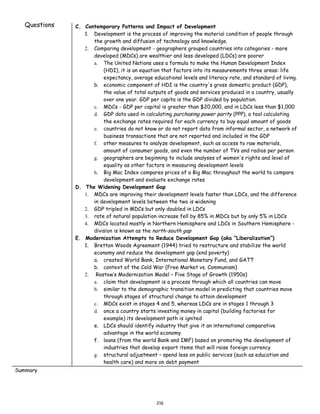
Development Gap Questions
- 1. Questions C. Contemporary Patterns and Impact of Development 1. Development is the process of improving the material condition of people through the growth and diffusion of technology and knowledge. 2. Comparing development - geographers grouped countries into categories - more developed (MDCs) are wealthier and less developed (LDCs) are poorer a. The United Nations uses a formula to make the Human Development Index (HDI), it is an equation that factors into its measurements three areas: life expectancy, average educational levels and literacy rate, and standard of living. b. economic component of HDI is the country's gross domestic product (GDP), the value of total outputs of goods and services produced in a country, usually over one year. GDP per capita is the GDP divided by population. c. MDCs - GDP per capital is greater than $20,000, and in LDCs less than $1,000 d. GDP data used in calculating purchasing power parity (PPP), a tool calculating the exchange rates required for each currency to buy equal amount of goods e. countries do not know or do not report data from informal sector, a network of business transactions that are not reported and included in the GDP f. other measures to analyze development, such as access to raw materials, amount of consumer goods, and even the number of TVs and radios per person g. geographers are beginning to include analyses of women's rights and level of equality as other factors in measuring development levels h. Big Mac Index compares prices of a Big Mac throughout the world to compare development and evaluate exchange rates D. The Widening Development Gap 1. MDCs are improving their development levels faster than LDCs, and the difference in development levels between the two is widening 2. GDP tripled in MDCs but only doubled in LDCs 3. rate of natural population increase fell by 85% in MDCs but by only 5% in LDCs 4. MDCs located mostly in Northern Hemisphere and LDCs in Southern Hemisphere - division is known as the north-south gap E. Modernization Attempts to Reduce Development Gap (aka “Liberalization”) 1. Bretton Woods Agreement (1944) tried to restructure and stabilize the world economy and reduce the development gap (end poverty) a. created World Bank, International Monetary Fund, and GATT b. context of the Cold War (Free Market vs. Communism) 2. Rostow’s Modernization Model – Five Stage of Growth (1950s) a. claim that development is a process through which all countries can move b. similar to the demographic transition model in predicting that countries move through stages of structural change to attain development c. MDCs exist in stages 4 and 5, whereas LDCs are in stages 1 through 3 d. once a country starts investing money in capital (building factories for example) its development path is ignited e. LDCs should identify industry that give it an international comparative advantage in the world economy f. loans (from the world Bank and IMF) based on promoting the development of industries that develop export items that will raise foreign currency g. structural adjustment – spend less on public services (such as education and health care) and more on debt payment Summary 216
- 2. Questions F. Dependency Theory Criticism of Modernization (Liberalization) Theory 1. since World War II the development gap between LDCs and MDCs has widened 2. dependency theory claims that this has been intentional 3. it is a structuralist perspective, arguing that the political and economic relations among countries limit LDCs ability to modernize and develop 4. Immanuel Wallerstein's world-systems analysis a. divides the world into three groups: core, periphery, and semiperiphery b. core depends on the existence of a periphery (which it exploits) c. core and periphery can change over time 5. dependency theorists point to Europe's colonial occupation of Africa as a reason for present poverty - colonialism locked African nations in dependent relationship 6. dependency theory sees little hope for LDCs because the dominance of MDCs is highly linked to the continued economic and political inferiority of LDCs 7. criticized for not allowing for cultural and contextual geographic differences G. Alternative Approaches to Development 1. self-sufficiency approach, a country should spread its investments and development equally across all sectors of its economy and regions a. rural areas must develop along with urban areas, and poverty must be reduced across the entire country b. favors a closed economic state, in which imports are limited and heavily taxed so that local businesses can flourish without competing with foreign companies c. in the 20th century, China, India, eastern Europe, and Africa used this model d. corruption and inefficiency limited development - in India, for example, the government paid failing businesses to stay open and continue their work 2. international trade approach encourages international trade a. identify unique set of strengths and channel investment toward strengths b. LCDs find what it can offer the world and capitalize on that good or service. c. an example, Japan invested money and power into developing a comparative advantage in high-tech products and then exported to other countries d. Four East Asian Dragons (aka “Tigers”) - NICs (Newly Industrialized Countries) Taiwan, South Korea, Hong Kong, and Singapore 3. foreign direct investment - LDCs actively solicit foreign corporations' investment in their countries, referred to as foreign direct investment a. LDCs establish special economic zones - offering special tax breaks, eased environmental restrictions, and other incentives to attract foreign companies b. China's government has made special economic zones (SEZs) within its territory to allow foreign companies free-trade rights and to outsource 4. free trade versus fair trade a. MNCs are not paying workers in the periphery a living wage b. fair trade products are made and traded to protect workers and environment c. fair trade policies favor oversight of MNCs to ensure that workers (especially women) throughout the world are guaranteed a living wage for their work Summary Fold the page at the line and glue this part of the page into your notebook.